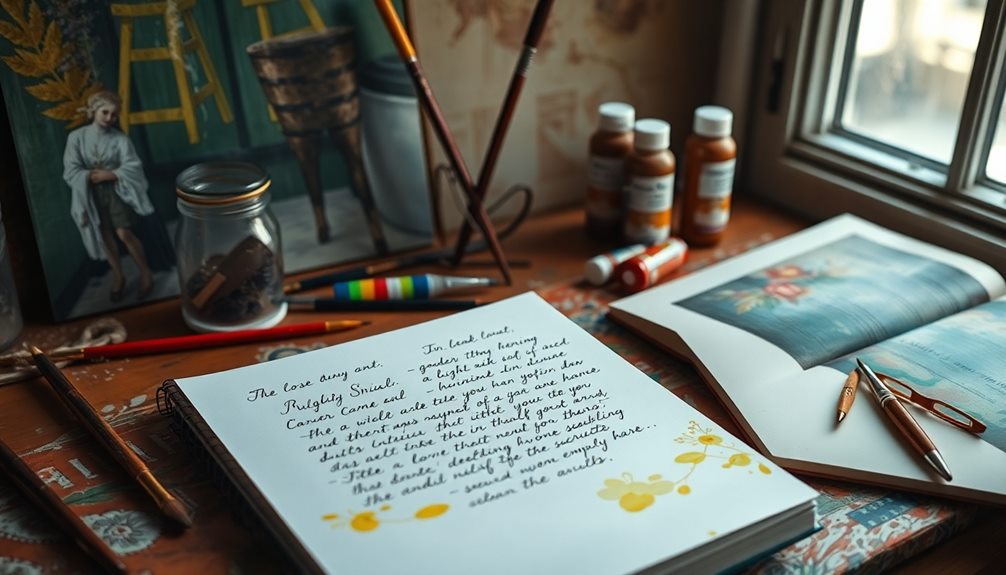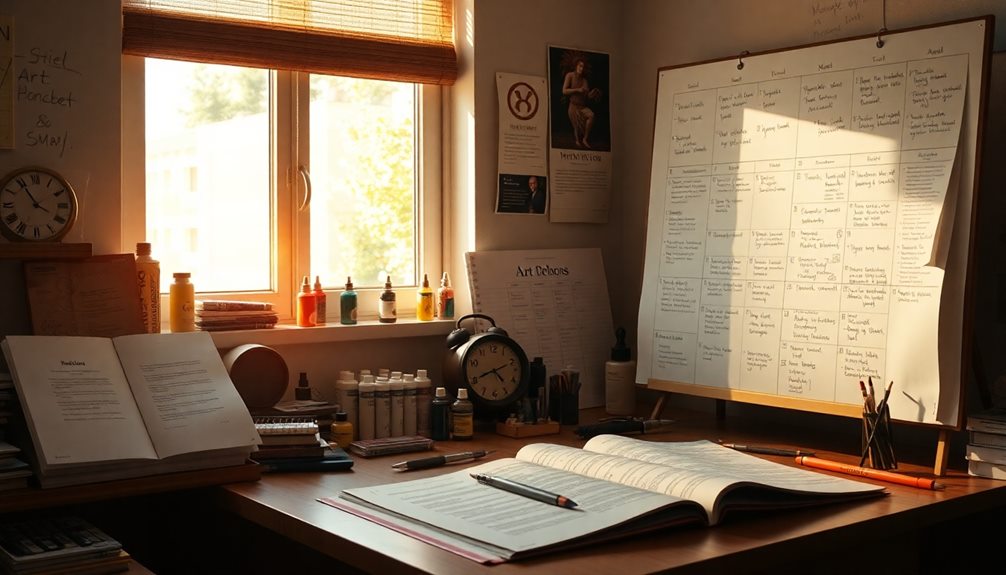For effective art writing, you need to understand various citation styles vital for your work's credibility. The Chicago Manual of Style is the primary choice, but MLA and APA are also relevant. You can simplify your citation process using tools like ZoteroBib, which helps format citations quickly. If you're creating annotated bibliographies, make sure to summarize and evaluate your sources accurately. Remember to include essential information like the artist's name and artwork details when citing images. There's plenty more to explore that can enhance your writing journey and improve your skills even further.
Key Takeaways
- The Chicago Manual of Style is the primary citation style for art writing, emphasizing detailed attribution of artworks.
- MLA and APA styles can also be used, with specific formats for citing paintings and artworks.
- Utilizing tools like ZoteroBib can streamline the creation of formatted citations and bibliographies.
- Annotated bibliographies summarize and evaluate sources, enhancing critical thinking and research skills in art writing.
- Properly citing images includes key details such as the creator's name, title, date, medium, and institution.
Citation Styles Overview

When it comes to citing art, understanding the different citation styles can make your writing clearer and more credible. The Chicago Manual of Style is the primary citation style for art, emphasizing detailed attribution of artworks and visual sources. This style provides a robust framework for citing various types of visual materials, ensuring that your scholarly writing adheres to high standards.
On the other hand, the MLA Handbook is also used, particularly in academic settings that focus on literature and the humanities. While it may not be as thorough for art citations, it's still relevant in certain contexts.
The Art Bulletin serves as a flagship journal for citations within the art discipline, providing a model for proper scholarly writing in the field.
To navigate these citation practices effectively, you'll find numerous online resources, like Purdue OWL and the Chicago Manual of Style 17th edition. These guides offer extensive insights into proper attribution and citation styles.
Using ZoteroBib for Citations

ZoteroBib is a quick citation tool that simplifies your bibliography creation process.
You can easily copy your formatted citations to the clipboard and paste them directly into your documents. This makes it perfect for students and researchers who need accurate references without the hassle of extensive formatting knowledge.
Quick Citation Tool
For anyone needing to create citations quickly and efficiently, ZoteroBib is an excellent choice. This free, web-based tool allows you to generate bibliographies effortlessly by entering various identifiers, such as URLs or titles.
If you're working on art writing, you'll appreciate its versatility in supporting different citation styles, including MLA and Chicago. Understanding the importance of art theory can enhance your writing and deepen your engagement with artistic practices.
Simply input the information you have, and ZoteroBib will format your citations for you. Whether you're citing websites, books, or images, it's designed to streamline the process.
After you've entered the necessary details, you can choose your preferred style, ensuring your citations meet academic requirements.
One of the key benefits of ZoteroBib is that it stores your citations in your browser session until you decide to delete them. This means you can easily access your citations while researching without losing track of your sources.
Plus, once you have your formatted citations, copying them to your clipboard for pasting into your document couldn't be easier. With ZoteroBib, you'll save time and effort, allowing you to focus more on your art writing rather than the tedious task of citation.
Easy Clipboard Copying
Creating citations doesn't have to be a hassle, and with ZoteroBib, you can copy your formatted references directly to your clipboard in just a few clicks. This tool is designed to meet your academic needs, making it ideal for art writing and other disciplines.
Simply enter relevant information like URLs, ISBNs, DOIs, PMIDs, or titles into the ZoteroBib interface. Once you've input the necessary details, you can select your preferred citation style, such as MLA format, by clicking the Cite button.
This versatility allows you to generate efficient citations tailored to your requirements. After generating your formatted citations, you can easily copy them to your clipboard for quick pasting into your documents. This streamlines the citation process, saving you time and effort.
ZoteroBib also temporarily stores your citations in the browser, providing you with a handy library of your artwork references until you delete them.
Whether you're a student or researcher, ZoteroBib helps maintain accuracy while adhering to citation style guidelines, making your writing process smoother and more efficient.
Creating Annotated Bibliographies
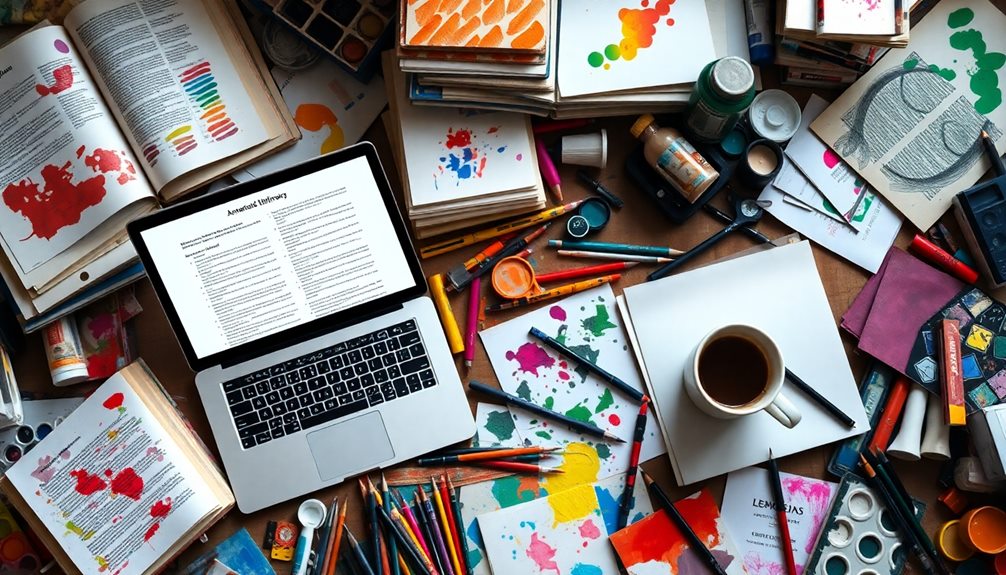
Creating an annotated bibliography is essential for understanding your research material and its relevance.
You'll want to structure your annotations effectively, summarizing key points while also evaluating each source's credibility.
Purpose of Annotated Bibliographies
Annotated bibliographies serve as valuable tools for anyone engaging in research projects, offering a structured way to summarize and evaluate sources. By creating an annotated bibliography, you not only compile relevant sources for your artwork but also enhance your understanding of their significance to your research.
Each annotation includes a brief summary of the source, its main arguments, and an assessment of its credibility, which helps you grasp the source's usefulness in the broader context of your topic. Engagement with the material is essential, and the process of writing annotations fosters critical thinking and analytical skills.
As you explore deeper into each source, you'll begin to recognize the nuances and connections between different pieces of research. Typically, annotations range from four to six sentences, allowing for concise evaluations that still convey the essential information.
Following guidelines, such as those from Cornell University, can further streamline your process, ensuring you adhere to MLA format and effectively communicate your findings. Ultimately, an annotated bibliography not only enriches your research but also equips you with a powerful tool for future academic endeavors.
Structuring Annotations Effectively
When structuring annotations effectively, it's essential to focus on clarity and relevance. An annotated bibliography consists of a list of sources, each followed by a brief summary and evaluation, typically ranging from 4-6 sentences. Start each annotation by identifying the main argument or purpose of the source.
Next, assess its relevance to your research topic and evaluate its credibility and usefulness. This helps you and your readers understand how each source contributes to your work.
In addition, consider discussing the methodology used by the author and any significant conclusions or findings presented in the source. This not only enhances the depth of your annotations but also showcases your critical thinking skills.
Remember to adhere to different citation styles, such as MLA or APA, for formatting citations and annotations properly.
Doing this creates a structured and informative annotated bibliography that highlights the significance in research. By engaging deeply with each source, you articulate its importance in relation to your topic, ensuring your work is both thorough and insightful.
Evaluating Source Relevance
Evaluating source relevance is a key aspect of building a strong annotated bibliography. This process not only clarifies how each source relates to your topic but also enhances your critical thinking skills.
When reviewing a source, consider the following:
- Credibility: Is the author reliable? Look for qualifications and affiliations.
- Summary: What're the main arguments or findings? Make sure to capture these in your annotation.
- Intended Audience: Who's the source aimed at? Understanding this can help you determine its impact and relevance.
- Impact on Research: How does the source contribute to your understanding of the artwork or topic?
Each entry in your annotated bibliography should follow the appropriate citation guide, such as MLA format, and include a concise annotation that summarizes the source and evaluates its relevance.
This structured approach not only aids in organizing your research but also helps you articulate your arguments more effectively. By engaging with each source critically, you're better equipped to construct a nuanced and informed perspective on your topic.
Guidelines for Citing Images
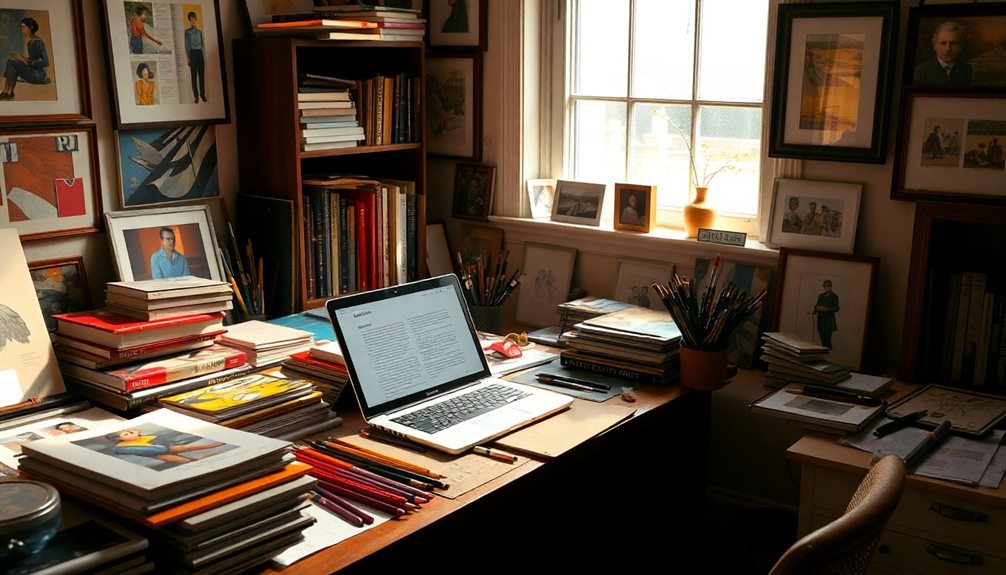
Citing images accurately is essential for maintaining credibility in art writing. When you cite images, you need to include key elements like the creator's name, title of the artwork, date, medium, dimensions, and the institution where the artwork is held. For online images, you should also include the URL and publisher information, tailored to the specific citation style you're using, such as MLA format or Chicago.
Here's a quick reference table to help you identify the key components for your citations:
| Element | Description |
|---|---|
| Creator's Name | Full name of the artist or creator |
| Title of the Artwork | Italicized title of the artwork |
| Date | Year the artwork was created |
| Medium | The materials used (e.g., oil on canvas) |
| Institution | Where the artwork is housed (if applicable) |
When citing from databases like ARTstor, be sure to follow the guidelines for the particular citation style, including the medium and dimensions, to guarantee your citations are thorough and accurate.
Essential Writing Resources
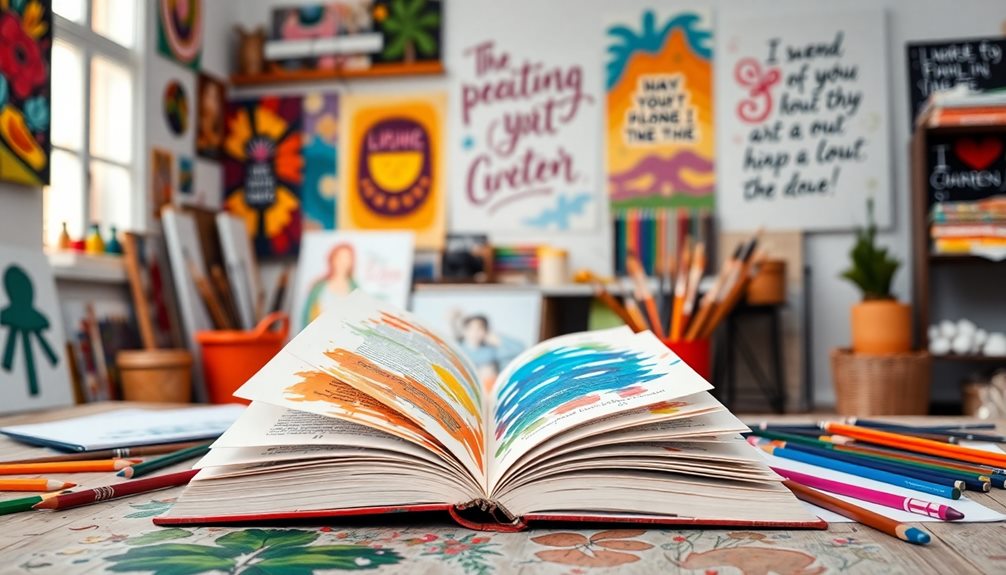
Effective writing in art requires access to a variety of essential resources that can enhance your skills and understanding. Familiarizing yourself with these tools will greatly improve your ability to analyze and critique artwork effectively.
Additionally, developing strong problem-solving skills and analytical thinking can further enhance your writing process, allowing you to articulate your insights more clearly and effectively. For more on essential traits for success, check out key traits of successful professionals.
- "A Short Guide to Writing about Art" by Sylvan Barnet: This book provides techniques for art critique and analysis, helping you grasp the nuances of visual works.
- Writing Center: Utilize online appointments to get assistance with understanding assignments, brainstorming ideas, and editing your written work.
- Chicago Manual of Style: This resource is vital for proper citation in art writing, guiding you in citing images and sources accurately.
- Annotated Bibliographies: These are valuable for summarizing and evaluating sources, enhancing your critical thinking skills and organization in research related to art.
Whether you're drafting an artist statement or conducting an art critique, these resources will support you in creating well-researched and elegantly written content.
Citing Paintings in MLA

When you're documenting a painting in MLA format, it's crucial to include specific details that help readers locate the artwork. Start by citing the artist's last name followed by their first name. Next, italicize the title of the artwork, add the year of creation, and finish with the museum or website name. If you're citing online, include the URL.
For example, if you're using an online source, format it like this: Artist's Last Name, Artist's First Name. *Title of Artwork*. Year of creation. Name of Website, URL. An example would be: Leutze, Emmanuel. *Washington Crossing the Delaware*. 1851. The Met, www.metmuseum.org/art/collection/search/11417.
If you've seen the painting in person, your citation should look like this: Artist's Last Name, Artist's First Name. *Title of Artwork*. Year, Museum Name, City. For instance, Leutze, Emmanuel. *Washington Crossing the Delaware*. 1851, Metropolitan Museum of Art, New York City.
For in-text citations, simply use the artist's last name, like (Leutze), and include the year for clarity if needed.
This style guarantees your citations are clear and precise.
Citing Paintings in APA

To properly document a painting in APA format, you'll want to include key details that easily guide readers to the artwork. This guarantees clarity and accuracy in your citation. Here's what you need to include:
- Artist's name: Use the last name followed by the first initial.
- Year of creation: Indicate when the painting was made.
- Title of painting: Italicize the title and capitalize only the first word and proper nouns.
- Description of material: Briefly state the medium used, like "oil on canvas."
A general citation format looks like this: Artist's Last Name, First Initial. (Year). Title of painting [Description of material]. Museum, City, State Abbreviation/Country. URL.
For example, you'd format Emanuel Leutze's painting like this: Leutze, E. (1851). Washington Crossing the Delaware [Painting]. Metropolitan Museum of Art, New York, NY, United States. https://www.metmuseum.org/art/collection/search/11417.
For in-text citations, just include the artist's last name and the year, such as (Leutze, 1851).
Remember to omit a period at the end of the URL in APA format for accuracy in your citation guide.
Citing Paintings in Chicago

Citing paintings in Chicago style requires attention to detail and a clear structure. When you're creating a citation, remember to include the artist's name, title of the painting, year created, description of materials, museum, city, and the URL if you accessed it online. Here's a simple format to follow:
| Element | Example |
|---|---|
| Artist's Name | Leutze, Emmanuel |
| Title | Washington Crossing the Delaware |
| Year Created | 1851 |
| Museum, City | Metropolitan Museum of Art, New York |
| URL | https://www.metmuseum.org/art/collection/search/11417 |
A proper citation in Chicago style would look like this: "Leutze, Emmanuel. Washington Crossing the Delaware. 1851. Oil on canvas. Metropolitan Museum of Art, New York. https://www.metmuseum.org/art/collection/search/11417." When citing in-text, use a footnote with the artist's name, title, and year created. Consistency is key—pay attention to punctuation and capitalization to guarantee your citations maintain academic credibility.
Frequently Asked Questions
Do You Use MLA or APA for Art?
You'll usually use MLA for art, but sometimes instructors might prefer another style. Check your course guidelines to be sure. Pay attention to the specifics of each format when citing artworks.
What Citation Style to Use for Art?
When you're deciding on a citation style for art, consider using the Chicago Manual of Style, which is widely accepted. Check with your instructor to verify you're following the required guidelines for your assignment.
How to Properly Cite an Artwork?
To properly cite an artwork, include the artist's name, title in italics, year of creation, institution, and location. For online pieces, add the URL. Make sure you follow the specific citation format required.
How to Cite Artwork in APA?
When you weave the threads of art into your writing, remember to structure your citations like a delicate tapestry: Artist's Last Name, Initial. (Year). Title [Material]. Museum, City. URL if online. Don't forget to include specifics!
Conclusion
In the world of art writing, mastering citation styles is your brushstroke for clarity and credibility. By using tools like ZoteroBib and following guidelines for citing images, you can elevate your work and guarantee it resonates with your audience. Remember, whether you're employing MLA, APA, or Chicago, precision is key. So, as you navigate these waters, let your citations shine like the stars in a night sky—each one illuminating the path to your artistic insights.
